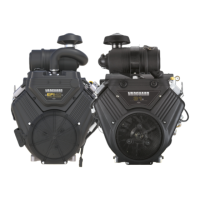NOTE: On engines equipped with"battery-less" charging
systems, the output should be between 12.9 and 13.9 VDC.
Anti-Afterfire Solenoid - Carbureted Engines
The anti-afterfire solenoid, mounted to the carburetor,
operates a plunger that stops the flow of fuel through the fixed
main jet. This is controlled by the equipment ignition switch.
With the ignition switch in the OFF position, the solenoid
plunger closes, stopping the flow of fuel. With the switch in
the ON and in the START positions, the solenoid plunger
opens to allow normal fuel flow.
The solenoid is operating as normal if it CLICKS when the
ignition switch is turned ON and OFF.
If the solenoid does not CLICK, a problem may exist in the
equipment wiring, engine wiring, or the solenoid. Perform the
following tests in the order listed below.
Solenoid Test
1. Disconnect the wire harness electrical connector
and remove the anti-afterfire solenoid from the
carburetor (see SECTION 6 - SERVICE ENGINE
SUBASSEMBLIES - Carburetor - Disassembly). Wrap
with a shop towel to catch any spilled fuel.
2. Connect a jumper wire from the negative terminal of the
equipment 12V battery to either terminal of the solenoid
connector.
3. Connect a jumper wire from the positive terminal of
the equipment 12V battery to the other terminal of the
solenoid connector.
The plunger should retract freely.
When the battery connection is removed, the plunger should
return to the extended position.
Replace the solenoid if the plunger sticks or doesn't move.
NOTE: Test the anti-afterfire solenoid when at room
temperature and when the engine is at operating
temperature. Excessive heatmay cause failure.
EquipmentWiring Test
1. Turn the key switch to OFF.
2. Disconnect the equipment wiring harness from the
engine wiring harness.
3. Obtaina digital multimeter.
4. Attach the REDmeter test lead into the equipment
wiring harness connector(side opposite of raised rib on
harness connector).
5. Attach the BLACK meter test lead to a good ground.
6. Turn the key switch to ON. The multimeter should display
battery voltage.
If the meter DOES NOT display battery voltage, the
problem exists within the equipment wiring harness.
Consult equipment repair manual for testing procedures.
If the meter DOES display battery voltage, test the
engine wiring harness. See Testing Engine Wiring
Harness in this section.
Testing the Battery
BatteryVoltageTest
1. Verify that the correct battery for the engine and
application is installed. Consult the equipment owner's
manual for proper battery specification.
2. Obtain a digital multimeter.
3. Connect the RED test lead to the volt/ohm receptacle
of the meter and the BLACK test lead to the COM
receptacle of the meter.
4. Select DC VOLTS on the multimeter.
5. Attach the RED meter test lead probe to the POSITIVE
(+) battery terminal.
6. Attach the BLACK meter test lead probe to the
NEGATIVE (-) battery terminal.
7. Observe the multimeter display. Record results.
The multimeter display should display 12 volts or
ABOVE on a good battery. If the battery voltage is
between 10-12 volts, fully charge the battery prior to
continuing with troubleshooting. If the battery voltage is
less than 10 volts, replace the battery prior to continuing
troubleshooting.
NOTE: If testing battery voltage on a gaseous-fueled
standby generator engine, the observed battery voltage
must read 13 volts or higher. Standby home generators
are equipped with a battery charge maintenance
circuit, or "trickle-charger" that maintains battery
voltage. If battery voltage of LESS THAN 13 volts is
observed, check the battery maintenance charger
circuit. See Air-Cooled Standby Generator Electrical
Troubleshooting and Repair Manual for troubleshooting
and testingprocedures.
8. Proceed to Battery Load Test.
Battery Load Test
To perform a battery load test WITHOUT the use of a battery
load test tool, proceed as follows. If using a battery load test
tool, see tool instructions for proper testing procedures.
1. Obtain a digital multimeter.
2. Connect the RED test lead to the volt/ohm receptacle
of the meter and the BLACK test lead to the COM
receptacle of the meter.
3. Select DC VOLTS on the multimeter.
39

